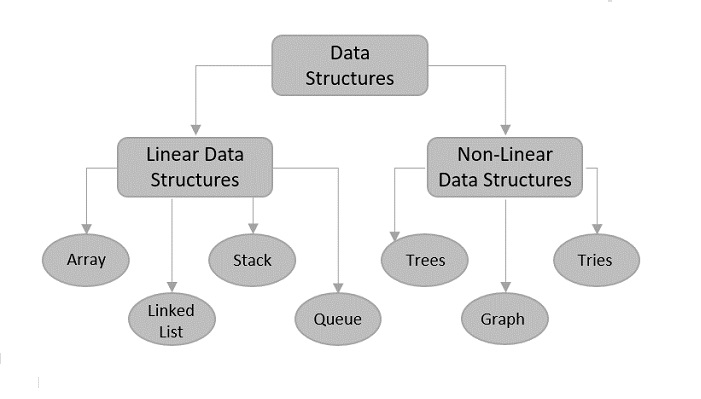Types of Data Structures

Data structures are broadly categorized into two main types:
Primitive Data Structures: These are basic data structures that are directly supported by programming languages. They include:
a. Integer: Stores whole numbers (e.g., 1, 2, -3).
b. Float/Double: Stores decimal numbers (e.g., 3.14, -0.5).
c. Character: Stores individual characters (e.g., 'a', 'b', '1').
d. Boolean: Stores true or false values.
e. Pointers: Stores memory addresses of other variables or data structures.
Abstract Data Structures (ADS): These are complex data structures that are built using primitive data types and offer higher-level abstractions for organizing and managing data efficiently. Some common abstract data structures include:
a. Arrays: A collection of elements stored in contiguous memory locations, where each element is accessed by its index. Arrays can be one-dimensional, multi-dimensional, or jagged.
b. Linked Lists: A linear data structure consisting of nodes, where each node contains a data element and a reference (or pointer) to the next node in the sequence. Linked lists offer dynamic memory allocation and efficient insertion and deletion operations.
c. Stacks: An abstract data type that follows the Last In, First Out (LIFO) principle. Elements are added and removed from the top of the stack. Stacks are commonly used in function call management, expression evaluation, and backtracking algorithms.
d. Queues: An abstract data type that follows the First In, First Out (FIFO) principle. Elements are added at the rear (enqueue) and removed from the front (dequeue) of the queue. Queues are used in scheduling algorithms, breadth-first search, and multi-threading.
e. Trees: A hierarchical data structure consisting of nodes connected by edges, with each node having a parent-child relationship. Trees are used in hierarchical data representation, searching, and sorting.
f. Graphs: A non-linear data structure consisting of vertices (nodes) connected by edges. Graphs can be directed or undirected and represent relationships between entities in various real-world scenarios.
g. Hash Tables: A data structure that stores key-value pairs and uses a hash function to map keys to their corresponding values in an array. Hash tables offer constant-time average-case lookup, insertion, and deletion operations and are used in associative arrays, databases, and caches.
Each type of data structure has its own advantages, disadvantages, and use cases. The choice of data structure depends on factors such as the nature of the data, the operations to be performed, memory constraints, and performance requirements.
Thank you,